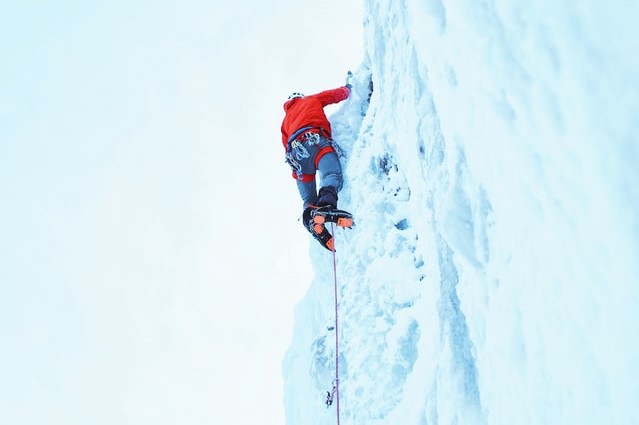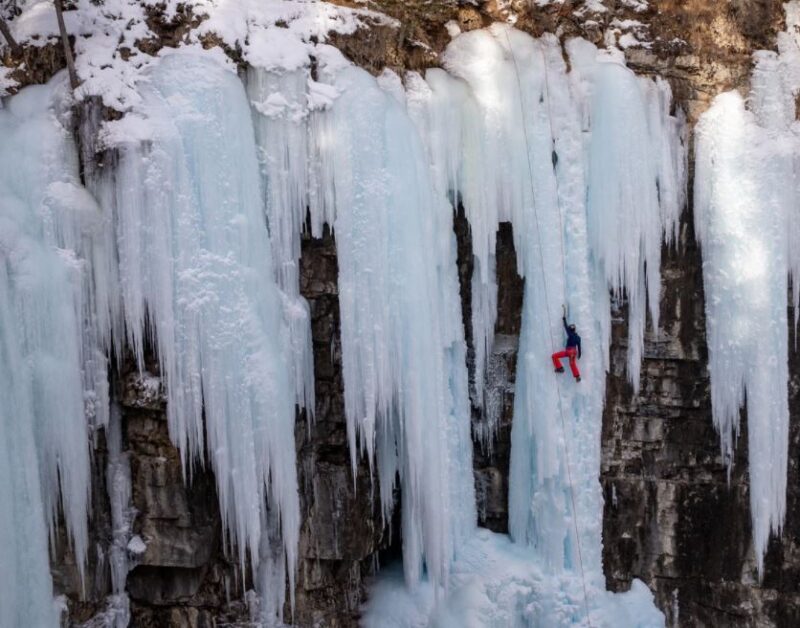Your huddle close to the icy face, a stiff breeze so cold it could freeze a polar bear whips past you, it finds its way down into the multiple layers of clothing you have on, sending a chill into your spine. You look up while holding your climbing partner’s rope in the brake position and the wind hits you directly in the face this time, causing your eyes to narrow as you see the climber clip in their rope and start to ascend again.

All the while focusing in your mind how you need to warm your joints up before following them towards the top of the frozen waterfall you are standing beneath. Ice climbing is a fascinating climbing sub sport that has increased in popularity over the years, so read on for an in depth guide on the how’s and why’s people undertake this adventurous sport. Introducing to you the world of ice climbing.
How it Works
Like other forms of climbing, when we ice climb we almost always climb as part of a team. In essence, the climber uses crampons with solid boots on to gain a foothold in the ice, while using two ice axes for their hands to also gain traction. The climber ascends the ice wall using this equipment gaining solid purchase with one while moving the other.

To keep safe every 3-5m or so, the climber will place an ice screw into the frozen waterfall and clip in a quick draw or carabiner, followed by the rope they are trailing, which is being controlled by the belayer below. This is continued over and over until the top is reached. There an anchors system is established and the belayer subsequently climbs up and retrieves the ice screws on the way.
History of Ice Climbing
Humans have been climbing for eons, usually for military purposes and ice climbing is no different. Think of Hannibal crossing the Alps into Rome as a combination of hiking, scrambling and climbing over ice. Modern ice climbing is usually undertaken as part of a wider expedition, such as a mountain ascent, with some sections being vertical enough to require this style.

In the 19th century European Alps, people began to ice climb for fun, rather than as part of an expedition and after the first crampons were developed in the early 20th century it increased in popularity. Like modern rock climbing, the general population’s leisure time increased from the 1970’s onwards leading to more involvement in the sport, where people have access to it.
Types of Ice Climbing
While the style of climbing stays the same, there are some different types of ice itself that offer up some differing challenges.
Alpine Ice
This is ice that has formed as multiple snow falls and gets compacted over time and forms hard ice and glaciers. This type of ice can literally take millions of years to form and is often called ‘blue ice’ Climbs on alpine ice tend to not be too vertical and more like very long steep slopes.
Water Ice
The ice here forms much quickly, seasonally in fact and comes in the form of frozen lakes, rivers and for climbing – waterfalls. This is the vertical style of ice climbing, up that waterfall that can change every time you climb it due to differing freeze and thaw patterns.
Mixed Climbing
Traditional rock climbing and ice climbing collide here and equipment for both, as well as the knowledge and skill are required.
Ice Climbing Skills and Technique
Climbing
It may seem obvious that someone who wants to go climbing needs to know who to climb, but it is a skill that needs practice and honing over time to become stronger, more efficient and faster when we move up the ice. Rock climbing is a great lead in as many principles are the same, such as moving your weight around to climb efficiently. Using crampons and ice axes to climb with is essential.
Gear placement
While not as specific as traditional climbing, ice climbers need to know how to place an ice screw, attach a quick draw or carabiner to it and then their rope. Anchor skills at the top of the climb are another absolute must as you will need to place the screws and then build your anchor to belay up your partner.
Belaying
This is where the team work comes in, belaying is the act of controlling the rope to make the climber as safe as possible (ice climbing is lead climbing after all), catch them if they fall and lower them to the ground if needed. Belaying also encompasses dealing with an injured climber and the ability to escape your belay and go and rescue the climber if required.

Abseiling or Rappelling
Two names, same activity. Making a controlled descent on fixed or temporary ropes, both singular and double is an essential skill for any climber in any environment.
Rating System and Grading
There are many different climbing grade systems around the world and ice climbing is no different. The most used system is from Canada and is the WI system (Water Ice). Climbs range from WI1 up until WI17 and is based on steepness rather than technical difficulty or the ‘feeling of difficulty; which factors in exposure etc. Some example grades
- A WI1 climb is technically very easy and is low angle ice requiring no tools.
- A WI12 climb has 60 degree angles requiring tools and protections
- A WI14 climb is over 70 degrees with bulges up to 90 degrees
- A WI 17 climb is min 90 degrees on thin or poorly bonded ice with difficult sections for placing protection.
Ice Climbing Tips
Ice climbing is not for the faint hearted nor is it for the inexperienced. Having previous climbing experience is a definite advantage, especially lead climbing, as many principles are the same. It is not essential however, as the climbing techniques are technically quite different and the placing of ice screws as your safety points are stronger and easier than placing traditional gear while climbing.
The best tip when it comes to ice climbing is, you must embrace the cold and be happy to potentially walk many hours in and out from the climb, deal with wild weather and heavy snow. Being comfortable in the cold winter environment and having some basic snow survival skills are also recommended.
Ice Climbing Equipment
- Mountaineering Boots
- Crampons
- Ice Axes
- Helmet
- Harness with Ice clippers
- Backpacks for carrying the equipment
- Belay device, locking carabiners, anchor material
- Emergency equipment: first aid kit, survival kits for alpine conditions
- Ice screws
- Avalanche gear such as a transceiver and an extendable probe
- Communication device
- Ropes
- Cold weather clothing
- Supplies like food and water

Ice Climbing Costs
Equipment can be quite expensive with renting gear costing $30USD a day or at least $1500 USD to purchase a basic setup. Some rock climbing equipment can easily be re-purposed including ropes, most of the hardware and as long as your harness has slots for ice screws and is extendable enough to cover your extra layers for the cold, then that too. Transport costs can also add up and in many cases, you would be wise to hire a guide, which will be more expensive in Austria than it will be in Nepal.
Is Ice climbing difficult or beginner friendly
Lower grades of ice climbing may not be too difficult, but just getting to the point to do that can be a long process. Undertaking ice climbing training and then trudging through the snow to get to the start of your climb can take its toll meaning you will be tired before you even start the ice climb. All this makes ice climbing not the friendliest for a beginner wanting to have just have a try.
Finding an ice climbing guide
For those wanting to learn how to ice climb, here are some great sites to check out to explore more. Read up on Tyrol for Austria, Yamnuska for Canada, Ultimatefrance.com for France and Colorado Mountain School in the USA offer many courses in their alpine regions. India and Nepal all offer courses or experiences in ice climbing, but generally as part of a wider mountaineering course. If you would like to move into ice climbing, then contacting the nearest school that can teach you the skills necessary is a great first step.
Ice Climbing Terms
- Anchor. An artificial strong point that is made at the top and also sometimes at the bottom of a climb to create a no fail hard point to base a safety system on.
- On sight. Completing a climb first attempt with minimal knowledge of the route’s features.
- Ice Screw. A metal screw that is put into the ice to create a hard point for safety
- Crampons. Pointy metal cage like structure that fits over your boots and enable you to stick your foot into ice.
- Alpine climbing. Also mountaineering. A combination of all climbing skills required to climb mountain peaks.
- Approach. The walk, ski or snowmobile walk to the ice wall locations.

1 Comment
Mark Fingerhuth
March 11, 2022 at 10:18 pmGreat article! However, there seems to be a mistake in the grading/difficulty section since you wrote “WI14” but what you meant is “WI4”. Similar issue with WI12 vs WI2 etc